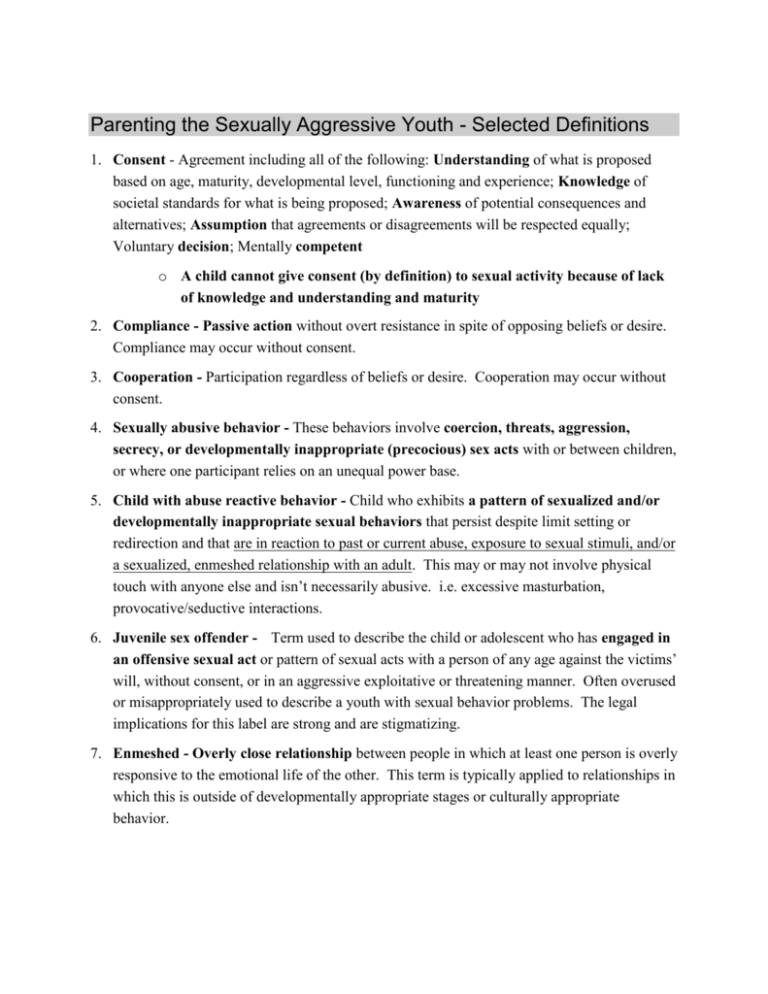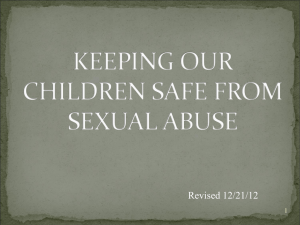
Parenting the Sexually Aggressive Youth - Selected Definitions
1. Consent - Agreement including all of the following: Understanding of what is proposed
based on age, maturity, developmental level, functioning and experience; Knowledge of
societal standards for what is being proposed; Awareness of potential consequences and
alternatives; Assumption that agreements or disagreements will be respected equally;
Voluntary decision; Mentally competent
o A child cannot give consent (by definition) to sexual activity because of lack
of knowledge and understanding and maturity
2. Compliance - Passive action without overt resistance in spite of opposing beliefs or desire.
Compliance may occur without consent.
3. Cooperation - Participation regardless of beliefs or desire. Cooperation may occur without
consent.
4. Sexually abusive behavior - These behaviors involve coercion, threats, aggression,
secrecy, or developmentally inappropriate (precocious) sex acts with or between children,
or where one participant relies on an unequal power base.
5. Child with abuse reactive behavior - Child who exhibits a pattern of sexualized and/or
developmentally inappropriate sexual behaviors that persist despite limit setting or
redirection and that are in reaction to past or current abuse, exposure to sexual stimuli, and/or
a sexualized, enmeshed relationship with an adult. This may or may not involve physical
touch with anyone else and isn’t necessarily abusive. i.e. excessive masturbation,
provocative/seductive interactions.
6. Juvenile sex offender - Term used to describe the child or adolescent who has engaged in
an offensive sexual act or pattern of sexual acts with a person of any age against the victims’
will, without consent, or in an aggressive exploitative or threatening manner. Often overused
or misappropriately used to describe a youth with sexual behavior problems. The legal
implications for this label are strong and are stigmatizing.
7. Enmeshed - Overly close relationship between people in which at least one person is overly
responsive to the emotional life of the other. This term is typically applied to relationships in
which this is outside of developmentally appropriate stages or culturally appropriate
behavior.
8. Post-Traumatic Stress Disorder (PTSD) - A diagnostic label assigned to an individual of
any age based on their exposure and continuing reaction to a traumatic event (natural
disaster, violence, victimization). Some symptoms include: flashbacks, nightmares,
dissociation, hyper-vigilance, and reenacting trauma through play or art.
9. Developmentally Appropriate Behaviors - Range of normal or typical behaviors within a
particular stage of development.
10. Sexual Misconduct - General term used to describe the behavioral act of engaging in
sexually offensive or abusive behaviors. (not labeling the person, but describing the
behavior)
11. Coercion - The act of compelling or forcing someone to do something by use of power,
intimidation, or threats
12. Sexual Offender - A common label used when referring to an individual who has engaged in
sexually offensive behavior(s), not a diagnosis. Generally a negative label that evokes
strong emotions and implies this offending behavior will continue. Is often used
interchangeably with juvenile sex abuser.
13. Pedophile - Typically, a diagnostic label assigned to an adult (16 or older) with primary or
exclusive sexual interest and arousal toward children. Often misused and cannot be used to
describe all sexual offenders.
14. Transference - Having feelings awakened or triggered by someone with whom you are
interacting based on your past relationships with someone considered significant.
15. Counter-Transference - Emotional reaction or feelings of person in a therapeutic role
toward person he or she is working with that is about their own “stuff” – personal history,
past experiences, and relationships. In other words - things that “push your buttons” and are
really stemming from your own “issues” and unresolved history and not what the person is
really doing.
16. Ritualistic Abuse - Bizarre, systematic, formalized, repetitive abuse which is mentally,
physically, and sexually abusive. Can be Satanic; such as devil-worship or sacrifices,
hypnosis, brain washing, or implanting evil and take place in a cult or other group setting.
The sexual abuse is usually painful, sadistic, and humiliating, intended as a means of gaining
dominance over the person.
A second definition is abuse (non-satanic) which involves any form of ritual (defined as a
“detailed procedure faithfully or consistently followed”). The ritual itself may not be
abusive but the “anticipatory fear” leading up to the abuse can be equally traumatizing.
Example: Every Wednesday at 4p.m. Sarah’s Uncle Joe comes to the house. Following a
brief discussion, her mother leaves for her church group. Uncle Joe then asks Sarah if she’d
like to watch TV. She knows that this means they will be sitting on the couch where Uncle
Joe will proceed to fondle her. Sarah begins having stomachaches and complains of feeling
ill every Tuesday in anticipation of the upcoming ritual leading to fondling.
17. Sexual Exploitation - Purposefully manipulating, taking advantage of another person to
get sexually gratified, to obtain some sexual benefit, without regard to the person’s wellbeing or consequences.
18. Pornography - Writings, pictures, videos depicting explicit or implied sexual behaviors
intended to arouse sexual desire.
19. Sexualized Behaviors - Learned use of sexual behaviors to get nurturance needs met.
Using sexual behaviors as the way to relate to people. Everyday behaviors and interactions
have a sexual meaning.
20. Psychosexual Assessment - A specialized assessment that can be requested to address the
following problem situations: inappropriate sexual behaviors, sexuality problems, and/ or
sexual abuse concerns or allegations. Could involve use of the following instruments: Child
Sexual Behaviour Inventory (CSBI) (Friedrich, 1997) and the Child Sexual Behaviour
Checklist (CSBCL) (Johnson, 1998c)








